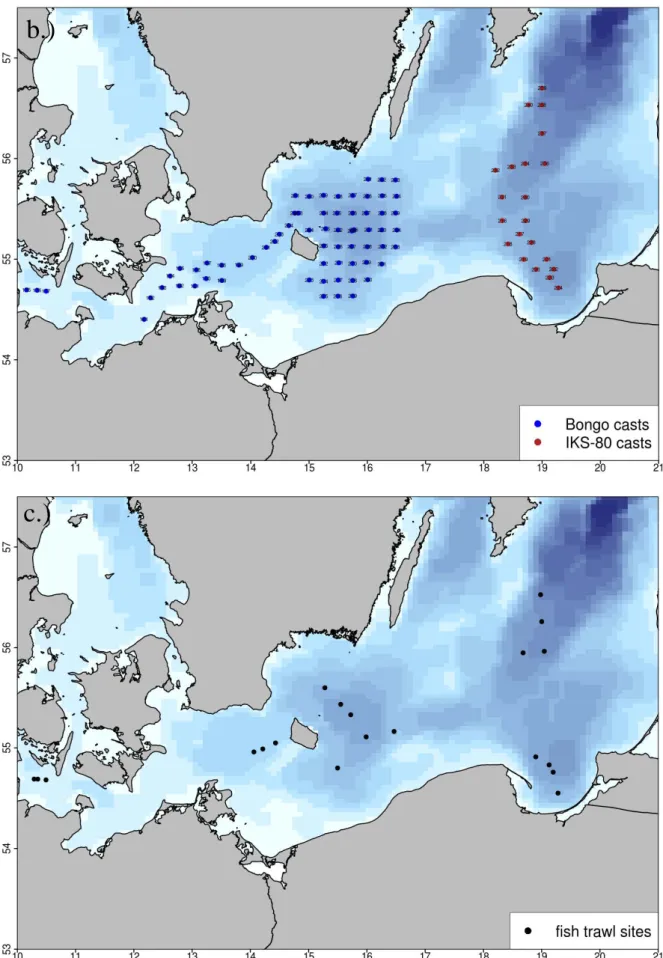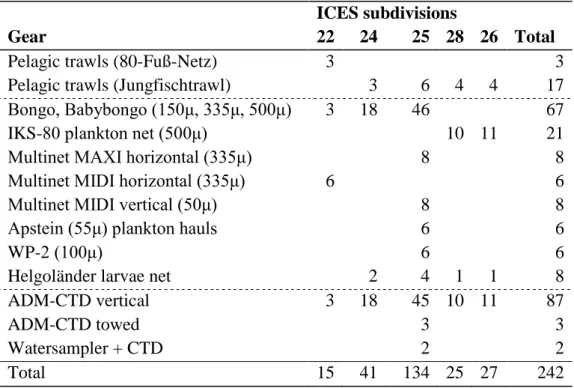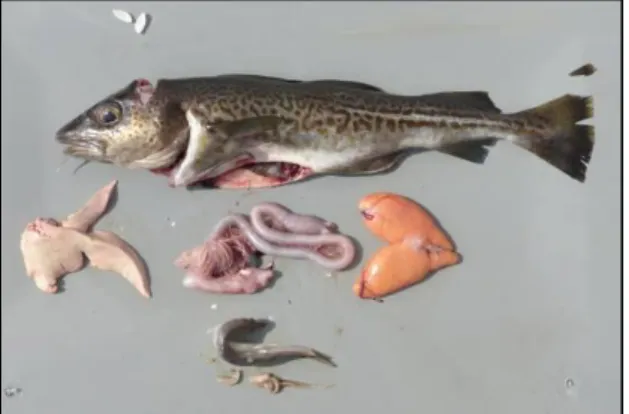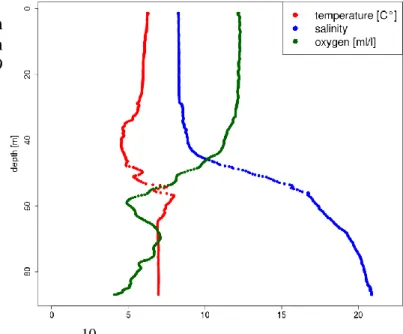Helmholtz Centre for Ocean Research Kiel Düsternbrooker Weg 20
24105 Kiel
Cruise Report
R.V. ALKOR Cruise No.: AL 454
Compiled by: Dr. Jan Dierking Dates of Cruise: 15.04. – 29.04.2015
Areas of Research: Physical, chemical, biological and fishery oceanography
Port Calls: Rönne, Denmark, 17.04.2015-18.04.2015; Kalmar, Sweden, 23.04. – 24.05.2014 Institute: GEOMAR, FB3 (Marine Ecology, Evolutionary Ecology of Marine Fishes) Chief Scientist: Dr. Jan Dierking
Number of Scientists: 12 Projects: BONUS BIO-C3
Cruise Report
This cruise report consists of 13 pages including the cover page:
1. Scientific crew………... 2
2. Research program………...…. 3
3. Narrative of cruise with technical details………. 6
4. Detailed cruise timeline………... 6
5. Scientific report and first results……… 8
6. Scientific equipment ………..………..….. …….13
7. Acknowledgements………. 13
8. Appendix E1: Station list………. 13
1. Scientific crew
Name Function Institute Leg
Jan Dierking Chief Scientist GEOMAR Entire cruise
Svend Mees Scientist GEOMAR Entire cruise
Burkhard von Dewitz Scientist GEOMAR Entire cruise
Christoph Petereit Scientist GEOMAR Kiel - Kalmar
Sofia Nyberg Bachelor student Uppsala University, Sweden Entire cruise Gor Margayan Master student Kiel University (CAU) Entire cruise Anna Lena Kolze Master student Kiel University (CAU) Entire cruise
Stefanie Hatzky Intern GEOMAR Entire cruise
Paulina Urban Bachelor student Kiel University (CAU) Entire cruise Constantin Dransmann Bachelor student Kiel University (CAU) Entire cruise
Julio Greenway Intern GEOMAR Entire cruise
Rebecca Eliasson Research assistant
Swedish University of
Agricultural Sciences Kiel - Kalmar
Jamileh Javid Scientist GEOMAR Kalmar - Kiel
Total 12
Chief scientist:
Dr. Jan Dierking, GEOMAR Helmholtz Centre for Ocean Research Düsternbrooker Weg 20, 24105 Kiel
Phone: 0431 600 4580 Fax: 0431 600 4553 E-Mail: jdierking@geomar.de
2. Research program
This multidisciplinary cruise extended a long-term data series on (eco-) system composition and functioning of the Baltic Sea, with a focus on the deeper basins, collected since 1986 by the GEOMAR Helmholtz Centre for Ocean Research and its predecessors IFM-GEOMAR Kiel and IFM Kiel. The key characteristic of this series is the integration of oceanographic and biological information to enhance understanding of environmental and (fish) population fluctuations, and evolutionary processes in this system, in the context of climate change and anthropogenic stressors. The resulting datasets and samples are essential for the large-scale international project BONUS BIO-C3 coordinated by GEOMAR. The spatial focus lies on the Bornholm Basin (the most important spawning area of Baltic cod), but also includes the Western Baltic Sea, Arkona and Gotland Basin and Gdansk Deep (Figure 1), thus covering ICES subdivisions 22, 24, 25, 26 and 28 (Figure 2).
Figure 1 Cruise track of AL 454. KB = Kiel Bight, AB = Arkona Basin, BB = Bornholm Basin, GD = Gdansk Deep, GB = Gotland Basin
Figure 2 ICES subdivisions in the Baltic Sea area. Source: ICES
Specific investigations included a detailed hydrographic survey (oxygen, salinity, temperature, light intensity) (Figure 3 a), plankton surveys (zoo- and ichthyplankton, with the goal to determine the composition, abundance, vertical and horizontal distribution, and nutritional status of species, and to address questions regarding plankton phenology) (Figure 3 b), and pelagic fishery hauls (Figure 3 c). The latter served to determine size distributions, maturity status, and length – weight relationships of the three dominant fish species in the pelagic system of the Baltic, cod (Gadus morhua), herring (Clupea harengus) and sprat (Sprattus sprattus), as well as the benthic flatfish flounder (Plathichthys flesus). Secondly, various different samples were obtained for more detailed analyses, including gonad samples of cod, stomachs of cod, herring and sprat for dietary analyses, otoliths of cod for aging, and tissue samples of cod, flounder, whiting, plaice and others for genetic analyses. In addition, along the cruise track, hydroacoustic (echosounder) data were collected continuously for later analysis of fish abundance and distribution.
Additional cruise components were: (i) egg buoyancy experiments with flatfishes and cod, including the fertilization of eggs on board and measurements in density columns; (ii) Sampling and measurements to improve understanding of flounder stock structure and dynamics; (iii) additional cod gonad sampling for the determination of fecundity and histological studies; (iv) high detail, vertically resolved phytoplankton and zooplankton sampling for studies of plankton phenology (see Section 5.4 for details).
a.)
Figure 3 Stations covered during cruise AL 454. a.) Vertical CTD casts (red circles) and towed CTD transects (black lines). b.) Plankton sampling with Bongo (blue circles) and IKS-80 (red circles) nets.
c.) Fishery stations covered with pelagic trawls.
b.)
c.)
<D l ! )
l ! ) l ! )
....
l ! )
,.__
l ! )
<D l ! )
l ! ) l ! )
....
l ! )
...
~
... .
•
• • ••••••
_ .. -· G --- . ... . .
..,..
. - ..
••
. t:J " •
••
... • -
..
,.,.. -
3. Narrative of cruise with technical details
Cruise AL 454 successfully accomplished all key components of the ambitious work program that had been planned, with the exception of stations in Stolpe Trench that had to be cut due to initial technical problems with the fishery probe and a resulting unscheduled harbor stay in Rönne, Bornholm, Denmark, to carry out repairs on April 17-18. Weather conditions were generally good, allowing for continuous work over the entire cruise duration.
RV ALKOR departed from GEOMAR pier on April 15 at 10:45 (all times board time) and headed to the first research area in the Kiel Bight. Over the course of the cruise, pelagic fishery hauls, zooplankton hauls with Bongo/IKS-80 nets, Helgoländer larvae net and Multinet MIDI, and CTD hauls were then carried following a large-scale spatial sampling design covering Kiel Bight (SD22) on April 15-16, Arkona Basin (SD24) on April 16 and 18 (interrupted by the harbor repair days on April 17-18, see above), Bornholm Basin (SD25) on April 19-20 and 24-28, Gdansk Deep (SD26) on April 21, and Gotland Basin (SD28) on April 22-23 (Figures 1, 3, Appendix E1). In addition, hydroacoustic data obtained with four different echosounder frequencies (38, 70, 120 and 200 kHz) were continuously recorded. The scientific work was interrupted by a scheduled harbor stay in Kalmar, Sweden, on April 23-24 to debark two scientists and embark one new scientist.
In addition to the program above, the central deep station BB23 in Bornholm Basin was intensively sampled on two occasions, on April 19 07:59-11:14 (including CTD casts, zoo- and phytoplankton sampling with Bongo, Apstein and WP-2 nets, oxygen measurements of water samples obtained with the rosette water sampler using the Winkler method, micro- /nanoplankton sampling using the same water samples, and fishery hauls) and on April 27 06:15 – April 28 06:55 (same sampling as on April 19, followed by a detailed vertically and temporally resolved sampling of plankton communities by four towed Multinet MAXI and four vertical Multinet MIDI hauls over a 22 hour period, covering the water column in 5 m and 10 m depth layers, respectively).
Moreover, two towed CTD transects spanning Bornholm Basin from North to South (conducted from April 19 19:35 – April 20 06:25) and East to West (April 28 07:33-12:52) were carried out to obtain basin cross-sections following the large-scale inflow of North Sea water in the winter of 2014-2015.
Following the completion of the research program on April 28 at 12:52, RV ALKOR steamed for Kiel harbor and reached port on April 29 at 07:00. After unloading, the cruise ended at 09:00.
4. Detailed cruise timeline (all times board time):
Wednesday 04/15/2015
Loading equipment, leaving GEOMAR Westshore pier, steaming to Kiel Bight. 13:12 start of station work. CTD, Bongo, Multinet MIDI towed, Helgoländer larvae net, pelagic fishery.
Thursday 04/16/2015
Station work Kiel Bight/Arkona Basin. CTD, Bongo, pelagic fishery.
Table 1 Overview of all gear deployments during AL 454.
ICES subdivisions
Gear 22 24 25 28 26 Total
Pelagic trawls (80-Fuß-Netz) 3 3
Pelagic trawls (Jungfischtrawl) 3 6 4 4 17
Bongo, Babybongo (150μ, 335μ, 500μ) 3 18 46 67
IKS-80 plankton net (500μ) 10 11 21
Multinet MAXI horizontal (335μ) 8 8
Multinet MIDI horizontal (335μ) 6 6
Multinet MIDI vertical (50μ) 8 8
Apstein (55μ) plankton hauls 6 6
WP-2 (100μ) 6 6
Helgoländer larvae net 2 4 1 1 8
ADM-CTD vertical 3 18 45 10 11 87
ADM-CTD towed 3 3
Watersampler + CTD 2 2
Total 15 41 134 25 27 242
Friday 04/172015
Station work Arkona Basin. 10:12 interruption of station work following failure of fishery probe, unscheduled repair stop Rönne, Bornholm, Denmark (arrival 15:42)
Saturday 04/18/2015
After the successful repair of the fishery probe, continuation of station work in Arkona Basin, followed by station work Bornholm Basin. CTD, Bongo, pelagic fishery.
Sunday 04/19/2015
First detailed plankton sampling with Apstein, WP-2, and rosette water sampler on station BB23. From 19:35 until 06:25 on Monday 04/20, first CTD tow along N-S cross section of Bornholm Basin. Upon completion, continuation with fishery hauls in Bornholm Basin and Stolpe trench.
Tuesday 04/21/2015
Station work Gdansk Deep. CTD, IKS-80, pelagic fishery.
Wednesday 04/22/2015
Station work Gotland Basin. CTD, IKS-80, pelagic fishery.
Thursday 04/23/2015
09:00 Arrival Kalmar, Sweden, for scheduled harbor day, disembarkment of 2 scientists, embarkment of 1 scientist.
Friday 04/24/2015
16:06 Departure from Kalmar heading to first station in Bornholm Basin. Arrival at station 21:12. Until Monday 04/27/2015 continuation of station work CTD, Bongo.
Monday 04/27/2015
06:15 – Tuesday 04/28/2015 06:55 Second detailed plankton sampling on station BB23, followed by intensive 22 hour sampling with towed multinet MAXI, vertical multinet MIDI.
Tuesday 04/28/2015
07:33 – 12:52 Second CTD tow, E-W cross-section of Bornholm Basin. 12:52 steaming for Kiel harbor.
Wednesday 04/29/2015
07:00 Arrival Kiel West shore pier, unloading; 09:00 end of cruise.
5. Scientific report and first results
5.1 Ichthyo– and zooplankton sampling
Plankton haul locations and gear deployments are summarized in Table 1 and Bongo-/
Babybongo hauls (Kiel Bight to Stolpe Trench) and IKS-80 hauls (East of Stolpe Trench) are shown in Figure 3 b. Larvae of cod (Gadus morhua) (n = 13 in total), sprat (Sprattus sprattus) (n = 545), flounder (Plathichthys flesus) (n = 570) and other species (n = 26) were picked from the 500 μm bongo-samples as well as Multinet hauls and conserved at -80 °C for subsequent RNA/DNA analysis. All Bongo samples were also checked for the presence of gelatinous zooplankton. The jellyfish species Aurelia aurita, Cyanea capillata and the invasive combjelly Mnemiopsis leidyi were present regularly, whereas no larvae of Mnemiopsis leidyi were found. In light of the absence of Mnemiopsis in samples from cruises in April and May of previous years, the presence of Mnemiopsis (n = 69) points to a possible second invasion of the combjelly to the central Baltic, likely connected with the major Baltic inflow event in the winter 2014/2015. Mnemiopsis samples were conserved by drying on coffee filter paper for later DNA analysis, and the remainder of the Bongo samples was conserved in formalin for later determination of species composition and abundance of (ichthyo-)plankton.
Stations in the eastern part of Stolpe trench and the Gdansk Deep and Southern Gotland Basin were covered with IKS-80 instead of Bongo hauls (Figure 3 b) to ensure compatibility of data with a long-term IKS-80 sampling series maintained by the Latvian Fish Resources Agency (LATFRA; Andrei Makarcuks).
Repeated Multinet MAXI (335μ, towed, sampling of the water column in 5 m layers) and MIDI (50μ, vertical, sampling of the water column in 10 m layers) casts were done over a 24 hour period on April 27-28 on the central deep Bornholm Basin station BB23 to reveal the vertical distribution of ichthyo- and zooplankton. In addition, WP-2 (100 μm) and Apstein (55 μm) nets and the rosette water sampler were deployed to obtain nano/micro phytoplankton samples in the context of plankton phenology work within the BONUS BIO-C3 project (Dr.
Jörg Dutz, IOW) (see Section 5.4).
Total length (cm)
Frequency
70 60 50 40 30 20 10 200 150 100 50 0
5.2 Fishery
Information on the locations and number of pelagic fishery hauls by area/ICES SD are summarized in Table 1 and shown in Figure 3 c. In addition, hydroacoustic measurements of fish distribution patterns were recorded continuously over the duration of the cruise. The catch composition is shown in Table 2.
Table 2 Taxonomic composition in terms of number of individuals and biomass in the total fish catches obtained by pelagic trawls during AL 454.
Latin name Common name
Number of
individuals (n) Mass (kg)
Sprattus sprattus Sprat 75,477 828.1
Gadus morhua Cod 1,778 778.2
Clupea harengus Herring 1,481 75.5
Gasterosteus aculeatus Three-spined stickleback 330 0.6
Limanda limanda Common dab 308 37.2
Platichthys flesus Flounder 237 40.0
Pleuronectes platessa Plaice 58 17.9
Aphia minuta Transparent goby 26 0.0
Merlangius merlangus Whiting 24 4.8
Pomatoschistus minutus Sand goby 4 0.0
Hippoglossoides platessoides American plaice 3 NA
Enchelyopus cimbrius Fourbeard rockling 3 NA
Engraulis encrasicolus European anchovy 1 0.0
79,730 1782.3
Regarding cod, it was noticeable that higher catches were accomplished when the net was trawled on to the bottom, indicating a near benthic distribution and oxygen levels sufficiently high for cod in the bottom layers.
Figure 4 Relative length frequency distribution of cod measured during AL 454 (n = 1595).
Figure 5 Samples (otoliths, fin clips, stomach contents, gonads) and measures (total length, weight, gutted weight, liver and gonad weight) taken from 844 out of 1595 cod individuals caught during the cruise (illustrated here for a 38 cm female, maturity stage IV, with full stomach, from Bornholm Basin). Photo: Nickel
For each haul and the entire catch, catch weight and length frequencies of all species (illustrated in Figure 4 for cod) were taken. Stomach samples were taken from sprat (10 per 1 cm length class) and herring (10 per 2 cm length class). For cod, detailed single fish data (length, weight, sex and maturity stage) and corresponding samples (otoliths, fin clips for genetic analysis, stomachs for stomach content analysis, and gonads for fecundity analysis) were obtained for 844 individuals (see Figure 5 for illustration), and length and weight information were measured for an additional 751 individuals.
5.3 Hydrography
CTD profiles (see Figure 6 for example) from 89 stations (Figure 3 a) were obtained with the ADM-CTD and the HYDROBIOS water sampler with attached CTD. In the Bornholm Basin additional two transects were covered with a towed ADM-CTD for a higher resolution cross section of the hydrographic situation in the basin after the Major Baltic Inflow Event in the winter 2014/2015.
Conditions varied strongly between basins and stations within basins, and spatial patterns will be analyzed systematicall in the context of the long-term data series on hydrographic conditions. In general, salinity and oxygen content in deeper water layers in all areas west of the Gdansk Deep were generally higher than in previous years. In contrast, values in the Eastern Basins Gdansk Deep and Gotland Basin were not elevated compared to previous years. Stations in the Bornholm Basin were characterized by a permanent halocline starting at ca. 45 m depth, with sharply increasing salinity and decreasing oxygen levels below 50 to 60 m. However, oxygen conditions below the halocline varied around 5 ml/l and rarely decreased below 4.5 ml/l. This sharply contrasted with the situation found in April 2014, when near bottom oxygen levels rarely surpassed 1-2 ml/l, and thus underscored that the oxygenated North Sea water transported into the Baltic Sea by the winter inflow already positively affected of the Bornholm Basin. The relatively good oxygen situation also explained the distribution of cod adults near the bottom, indicated by increased catches with increasing proximity of the trawl to the bottom during AL 454, and by echosounder images viewed directly on board indicating a to near bottom distribution.
Figure 6 CTD profile from station BB23, central Bornholm Basin, obtained on April 19 during cruise AL 454.
5.4 Special projects
In addition to the work related to the extension of the Bornholm Basin long-term integrative data series, several “special projects” in the context of the EU BONUS project BIO-C3 were carried out successfully, and are summarized here briefly.
Project: Experiments on cod egg buoyancy and fertilization on board of RV Alkor, and analysis of inter-annual patterns in buoyancy and of potential drivers of changes.
(contributing to BONUS BIO-C3) Christoph Petereit (GEOMAR Kiel)
During cruise AL 454, > 895 individual egg buoyancies of cod (Gadus morhua), flounder (Platichthys flesus), dab (Limanda limanda), sprat (Sprattus sprattus) and four-bearded rockling (Rhinonemus cimbrius) were determined using combinations of plankton net hauls and artificial strip spawning of individuals caught by fisheries. In total, 27 egg batches were successfully fertilized and measured. The majority of well developing egg batches were received from flounder individuals (total n=14) from the Gotland Basin (7), Gdansk Deep (2) and Kiel Bight (5). This was accomplished by the continuous determination (every 12 hours) of three flounder egg batches until hatching in gradient columns. Nine cod egg batches were measured in total (Bornholm Basin =3; Gdansk Deep = 5; Gotland Basin = 1). Four dab egg batches could be fertilized in Kiel Bight. Of those, two were successfully continuously monitored during egg development until hatch, supplementing a pilot experiment carried out during cruise AL 435 in April 2014.
One other key result was the occurrence of spawning individuals, and of cod spawning activity in the eastern Basins (Gdansk Deep and southern Gotland Basin).
Project: Egg buoyancy and survival probabilities of the European flounder (Platichthys flesus) in different spawning areas of the Baltic Sea
(contributing to both BONUS BIO-C3 and INSPIRE)
Sofia Nyberg and Anders Nissling (Uppsala university, Sweden), Christoph Petereit (GEOMAR Kiel)
Stock dynamics of flounder in the Baltic Sea are largely unknown. Two ecologically different ecotypes exist, one with pelagic eggs spawning at higher salinities in the deep basins, and one with demersal eggs spawning at low salinities in coastal areas and on offshore banks. Fishery exists on a mixed stock. To achieve sustainable management there is a need for increased knowledge of population structure, spatial distribution and migration patterns.
During cruise AL 454, the relative importance of the two subpopulations within the deep-basin spawning flounder ecotype was assessed. This was done by analysis of differences in egg specific gravity/egg size between areas. For this purpose, flounder eggs were stripped, fertilized and egg specific gravity determined in a density gradient column. In addition, otoliths (trace element analysis) and fin clip (genetic analysis) and muscle samples (stable isotope analysis) were sampled to attempt the later classification of spatial patterns and
connectivity.
Results from this cruise are presently used to assess egg survival probabilities in different spawning areas in the wild, by comparing the ability of studied egg batches to obtain neutral egg buoyancy within the “reproductive volume” (at favorable conditions for egg development) in 2014 (stagnant conditions) and in 2015 (after the winter 2014-2015 inflow event). The work has also resulted in a Bachelor thesis submitted by Sofia Nyberg.
Project: Cod fecundity and histology of gonads (contributing to both BONUS BIO-C3 and INSPIRE)
Michele Casini and Rebecca Eliasson, Swedish University of Agricultural Sciences
In addition to individuals sampling and measurements of cod (see Section 5.2), sub-samples of gonads of all cod females stage IV (mature and likely to spawn in the 2015 spawning season) as well as a subset of females stable V and VI were taken on board, and are presently being analyzed in Lysekil, Sweden.
Project: Environmental control of spring bloom timing in important key species of lower trophic levels
(contributing to BONUS BIO-C3)
Jörg Dutz, Leibniz-Institut für Ostseeforschung Warnemünde (IOW)
This project stands in the context of zooplankton work in the framework of the BIOC3 project. Work during AL 454 focused on new data to increase understanding of the environmental control of spring bloom timing in important key species of lower trophic levels (Acartia spp., Temora longicornis, Pseudocalanus acuspes) and to resolve the role of phenology for the population dynamics and productivity of fish under contrasting forcing conditions. Recent evidence suggests that the timing of the typical seasonal biomass evolution of various species is highly variable, but the potential control by a combination of abiotic (e.g., temperature) and biotic (e.g., food abundance) are at present poorly understood.
Phytoplankton and zooplankton samples were taken successfully during the two intensive samplings of the deep central Bornholm Basin station BB23, on April 19 and 28.
6. Scientific equipment: instruments and gear
Hydrography:
- ADM-CTD with additional O2 sensor
- Hydrobios Water Sampler with CTD and O2 sensor Zooplankton:
- Baby Bongo-Net (150 μm) - Bongo-Net (335 μm) - Bongo Net (500 μm) - WP2 (100 μm) - Apstein net (55 μm) - Helgoländer larvae net Ichthyoplankton:
- Bongo-Net (335 μm and 500 μm)
- Hydrobios Multinet MAXI (335 μm horizontal tows)
- Hydrobios Multinet MIDI (300 μm horizontal tows and 50 μm vertical hauls) - IKS-80 (500 μm)
Fish:
- Jungfisch Trawl (pelagic trawls) (0.5 cm) and 80-feet net.
Hydroacoustic:
- 38, 70, 120 and 200 kHz-echosounder EK60.
7. Acknowledgements
I want to thank Captain Lass and the entire crew of RV ALKOR for their outstanding support during the cruise, Rudi Lüthje and Svend Mees for their help in preparing the cruise, Hans- Harald Hinrichsen for assistance with CTD datasets, and all participants for their good work on board.
8. Appendix E1: Station list of AL 454
Supplied with the report in electronic form as Excel table, “Appendix E1 – AL454 station list.xlsx”.




